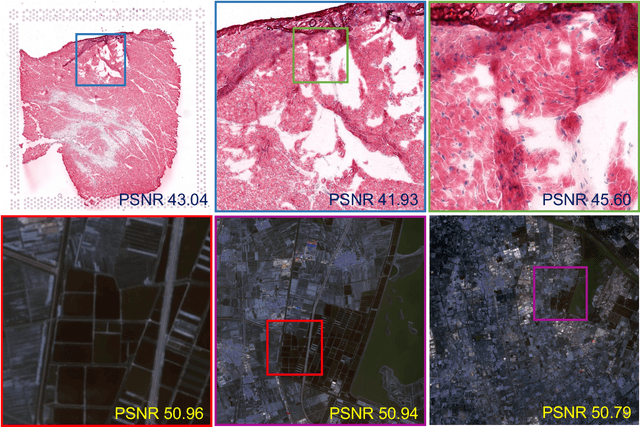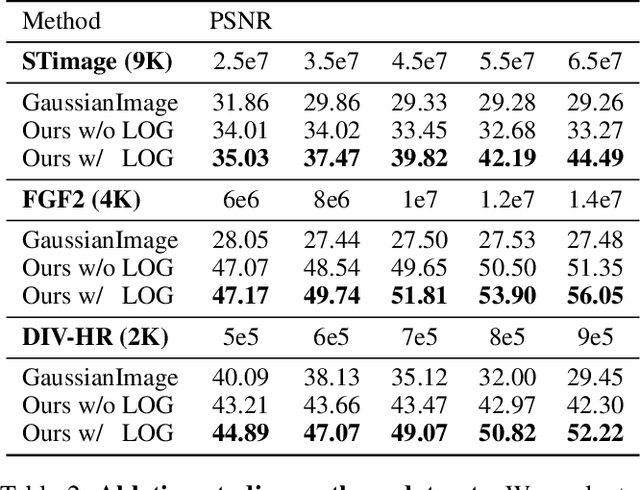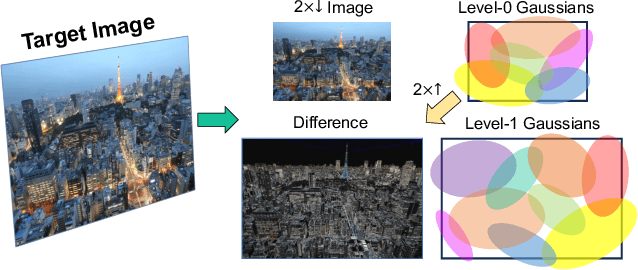Lequan Yu
Senior Member, IEEE
A Survey of Scientific Large Language Models: From Data Foundations to Agent Frontiers
Aug 28, 2025Abstract:Scientific Large Language Models (Sci-LLMs) are transforming how knowledge is represented, integrated, and applied in scientific research, yet their progress is shaped by the complex nature of scientific data. This survey presents a comprehensive, data-centric synthesis that reframes the development of Sci-LLMs as a co-evolution between models and their underlying data substrate. We formulate a unified taxonomy of scientific data and a hierarchical model of scientific knowledge, emphasizing the multimodal, cross-scale, and domain-specific challenges that differentiate scientific corpora from general natural language processing datasets. We systematically review recent Sci-LLMs, from general-purpose foundations to specialized models across diverse scientific disciplines, alongside an extensive analysis of over 270 pre-/post-training datasets, showing why Sci-LLMs pose distinct demands -- heterogeneous, multi-scale, uncertainty-laden corpora that require representations preserving domain invariance and enabling cross-modal reasoning. On evaluation, we examine over 190 benchmark datasets and trace a shift from static exams toward process- and discovery-oriented assessments with advanced evaluation protocols. These data-centric analyses highlight persistent issues in scientific data development and discuss emerging solutions involving semi-automated annotation pipelines and expert validation. Finally, we outline a paradigm shift toward closed-loop systems where autonomous agents based on Sci-LLMs actively experiment, validate, and contribute to a living, evolving knowledge base. Collectively, this work provides a roadmap for building trustworthy, continually evolving artificial intelligence (AI) systems that function as a true partner in accelerating scientific discovery.
AssetDropper: Asset Extraction via Diffusion Models with Reward-Driven Optimization
Jun 06, 2025Abstract:Recent research on generative models has primarily focused on creating product-ready visual outputs; however, designers often favor access to standardized asset libraries, a domain that has yet to be significantly enhanced by generative capabilities. Although open-world scenes provide ample raw materials for designers, efficiently extracting high-quality, standardized assets remains a challenge. To address this, we introduce AssetDropper, the first framework designed to extract assets from reference images, providing artists with an open-world asset palette. Our model adeptly extracts a front view of selected subjects from input images, effectively handling complex scenarios such as perspective distortion and subject occlusion. We establish a synthetic dataset of more than 200,000 image-subject pairs and a real-world benchmark with thousands more for evaluation, facilitating the exploration of future research in downstream tasks. Furthermore, to ensure precise asset extraction that aligns well with the image prompts, we employ a pre-trained reward model to fulfill a closed-loop with feedback. We design the reward model to perform an inverse task that pastes the extracted assets back into the reference sources, which assists training with additional consistency and mitigates hallucination. Extensive experiments show that, with the aid of reward-driven optimization, AssetDropper achieves the state-of-the-art results in asset extraction. Project page: AssetDropper.github.io.
StyleAR: Customizing Multimodal Autoregressive Model for Style-Aligned Text-to-Image Generation
May 26, 2025Abstract:In the current research landscape, multimodal autoregressive (AR) models have shown exceptional capabilities across various domains, including visual understanding and generation. However, complex tasks such as style-aligned text-to-image generation present significant challenges, particularly in data acquisition. In analogy to instruction-following tuning for image editing of AR models, style-aligned generation requires a reference style image and prompt, resulting in a text-image-to-image triplet where the output shares the style and semantics of the input. However, acquiring large volumes of such triplet data with specific styles is considerably more challenging than obtaining conventional text-to-image data used for training generative models. To address this issue, we propose StyleAR, an innovative approach that combines a specially designed data curation method with our proposed AR models to effectively utilize text-to-image binary data for style-aligned text-to-image generation. Our method synthesizes target stylized data using a reference style image and prompt, but only incorporates the target stylized image as the image modality to create high-quality binary data. To facilitate binary data training, we introduce a CLIP image encoder with a perceiver resampler that translates the image input into style tokens aligned with multimodal tokens in AR models and implement a style-enhanced token technique to prevent content leakage which is a common issue in previous work. Furthermore, we mix raw images drawn from large-scale text-image datasets with stylized images to enhance StyleAR's ability to extract richer stylistic features and ensure style consistency. Extensive qualitative and quantitative experiments demonstrate our superior performance.
Feature Preserving Shrinkage on Bayesian Neural Networks via the R2D2 Prior
May 23, 2025Abstract:Bayesian neural networks (BNNs) treat neural network weights as random variables, which aim to provide posterior uncertainty estimates and avoid overfitting by performing inference on the posterior weights. However, the selection of appropriate prior distributions remains a challenging task, and BNNs may suffer from catastrophic inflated variance or poor predictive performance when poor choices are made for the priors. Existing BNN designs apply different priors to weights, while the behaviours of these priors make it difficult to sufficiently shrink noisy signals or they are prone to overshrinking important signals in the weights. To alleviate this problem, we propose a novel R2D2-Net, which imposes the R^2-induced Dirichlet Decomposition (R2D2) prior to the BNN weights. The R2D2-Net can effectively shrink irrelevant coefficients towards zero, while preventing key features from over-shrinkage. To approximate the posterior distribution of weights more accurately, we further propose a variational Gibbs inference algorithm that combines the Gibbs updating procedure and gradient-based optimization. This strategy enhances stability and consistency in estimation when the variational objective involving the shrinkage parameters is non-convex. We also analyze the evidence lower bound (ELBO) and the posterior concentration rates from a theoretical perspective. Experiments on both natural and medical image classification and uncertainty estimation tasks demonstrate satisfactory performance of our method.
MedAgentBoard: Benchmarking Multi-Agent Collaboration with Conventional Methods for Diverse Medical Tasks
May 18, 2025Abstract:The rapid advancement of Large Language Models (LLMs) has stimulated interest in multi-agent collaboration for addressing complex medical tasks. However, the practical advantages of multi-agent collaboration approaches remain insufficiently understood. Existing evaluations often lack generalizability, failing to cover diverse tasks reflective of real-world clinical practice, and frequently omit rigorous comparisons against both single-LLM-based and established conventional methods. To address this critical gap, we introduce MedAgentBoard, a comprehensive benchmark for the systematic evaluation of multi-agent collaboration, single-LLM, and conventional approaches. MedAgentBoard encompasses four diverse medical task categories: (1) medical (visual) question answering, (2) lay summary generation, (3) structured Electronic Health Record (EHR) predictive modeling, and (4) clinical workflow automation, across text, medical images, and structured EHR data. Our extensive experiments reveal a nuanced landscape: while multi-agent collaboration demonstrates benefits in specific scenarios, such as enhancing task completeness in clinical workflow automation, it does not consistently outperform advanced single LLMs (e.g., in textual medical QA) or, critically, specialized conventional methods that generally maintain better performance in tasks like medical VQA and EHR-based prediction. MedAgentBoard offers a vital resource and actionable insights, emphasizing the necessity of a task-specific, evidence-based approach to selecting and developing AI solutions in medicine. It underscores that the inherent complexity and overhead of multi-agent collaboration must be carefully weighed against tangible performance gains. All code, datasets, detailed prompts, and experimental results are open-sourced at https://medagentboard.netlify.app/.
Proxy-Tuning: Tailoring Multimodal Autoregressive Models for Subject-Driven Image Generation
Mar 13, 2025



Abstract:Multimodal autoregressive (AR) models, based on next-token prediction and transformer architecture, have demonstrated remarkable capabilities in various multimodal tasks including text-to-image (T2I) generation. Despite their strong performance in general T2I tasks, our research reveals that these models initially struggle with subject-driven image generation compared to dominant diffusion models. To address this limitation, we introduce Proxy-Tuning, leveraging diffusion models to enhance AR models' capabilities in subject-specific image generation. Our method reveals a striking weak-to-strong phenomenon: fine-tuned AR models consistently outperform their diffusion model supervisors in both subject fidelity and prompt adherence. We analyze this performance shift and identify scenarios where AR models excel, particularly in multi-subject compositions and contextual understanding. This work not only demonstrates impressive results in subject-driven AR image generation, but also unveils the potential of weak-to-strong generalization in the image generation domain, contributing to a deeper understanding of different architectures' strengths and limitations.
Democratizing Large Language Model-Based Graph Data Augmentation via Latent Knowledge Graphs
Feb 19, 2025Abstract:Data augmentation is necessary for graph representation learning due to the scarcity and noise present in graph data. Most of the existing augmentation methods overlook the context information inherited from the dataset as they rely solely on the graph structure for augmentation. Despite the success of some large language model-based (LLM) graph learning methods, they are mostly white-box which require access to the weights or latent features from the open-access LLMs, making them difficult to be democratized for everyone as existing LLMs are mostly closed-source for commercial considerations. To overcome these limitations, we propose a black-box context-driven graph data augmentation approach, with the guidance of LLMs -- DemoGraph. Leveraging the text prompt as context-related information, we task the LLM with generating knowledge graphs (KGs), which allow us to capture the structural interactions from the text outputs. We then design a dynamic merging schema to stochastically integrate the LLM-generated KGs into the original graph during training. To control the sparsity of the augmented graph, we further devise a granularity-aware prompting strategy and an instruction fine-tuning module, which seamlessly generates text prompts according to different granularity levels of the dataset. Extensive experiments on various graph learning tasks validate the effectiveness of our method over existing graph data augmentation methods. Notably, our approach excels in scenarios involving electronic health records (EHRs), which validates its maximal utilization of contextual knowledge, leading to enhanced predictive performance and interpretability.
Large Images are Gaussians: High-Quality Large Image Representation with Levels of 2D Gaussian Splatting
Feb 13, 2025



Abstract:While Implicit Neural Representations (INRs) have demonstrated significant success in image representation, they are often hindered by large training memory and slow decoding speed. Recently, Gaussian Splatting (GS) has emerged as a promising solution in 3D reconstruction due to its high-quality novel view synthesis and rapid rendering capabilities, positioning it as a valuable tool for a broad spectrum of applications. In particular, a GS-based representation, 2DGS, has shown potential for image fitting. In our work, we present \textbf{L}arge \textbf{I}mages are \textbf{G}aussians (\textbf{LIG}), which delves deeper into the application of 2DGS for image representations, addressing the challenge of fitting large images with 2DGS in the situation of numerous Gaussian points, through two distinct modifications: 1) we adopt a variant of representation and optimization strategy, facilitating the fitting of a large number of Gaussian points; 2) we propose a Level-of-Gaussian approach for reconstructing both coarse low-frequency initialization and fine high-frequency details. Consequently, we successfully represent large images as Gaussian points and achieve high-quality large image representation, demonstrating its efficacy across various types of large images. Code is available at {\href{https://github.com/HKU-MedAI/LIG}{https://github.com/HKU-MedAI/LIG}}.
Dynamic Entity-Masked Graph Diffusion Model for histopathological image Representation Learning
Dec 13, 2024



Abstract:Significant disparities between the features of natural images and those inherent to histopathological images make it challenging to directly apply and transfer pre-trained models from natural images to histopathology tasks. Moreover, the frequent lack of annotations in histopathology patch images has driven researchers to explore self-supervised learning methods like mask reconstruction for learning representations from large amounts of unlabeled data. Crucially, previous mask-based efforts in self-supervised learning have often overlooked the spatial interactions among entities, which are essential for constructing accurate representations of pathological entities. To address these challenges, constructing graphs of entities is a promising approach. In addition, the diffusion reconstruction strategy has recently shown superior performance through its random intensity noise addition technique to enhance the robust learned representation. Therefore, we introduce H-MGDM, a novel self-supervised Histopathology image representation learning method through the Dynamic Entity-Masked Graph Diffusion Model. Specifically, we propose to use complementary subgraphs as latent diffusion conditions and self-supervised targets respectively during pre-training. We note that the graph can embed entities' topological relationships and enhance representation. Dynamic conditions and targets can improve pathological fine reconstruction. Our model has conducted pretraining experiments on three large histopathological datasets. The advanced predictive performance and interpretability of H-MGDM are clearly evaluated on comprehensive downstream tasks such as classification and survival analysis on six datasets. Our code will be publicly available at https://github.com/centurion-crawler/H-MGDM.
Aligning Knowledge Concepts to Whole Slide Images for Precise Histopathology Image Analysis
Nov 27, 2024Abstract:Due to the large size and lack of fine-grained annotation, Whole Slide Images (WSIs) analysis is commonly approached as a Multiple Instance Learning (MIL) problem. However, previous studies only learn from training data, posing a stark contrast to how human clinicians teach each other and reason about histopathologic entities and factors. Here we present a novel knowledge concept-based MIL framework, named ConcepPath to fill this gap. Specifically, ConcepPath utilizes GPT-4 to induce reliable diseasespecific human expert concepts from medical literature, and incorporate them with a group of purely learnable concepts to extract complementary knowledge from training data. In ConcepPath, WSIs are aligned to these linguistic knowledge concepts by utilizing pathology vision-language model as the basic building component. In the application of lung cancer subtyping, breast cancer HER2 scoring, and gastric cancer immunotherapy-sensitive subtyping task, ConcepPath significantly outperformed previous SOTA methods which lack the guidance of human expert knowledge.
 Add to Chrome
Add to Chrome Add to Firefox
Add to Firefox Add to Edge
Add to Edge